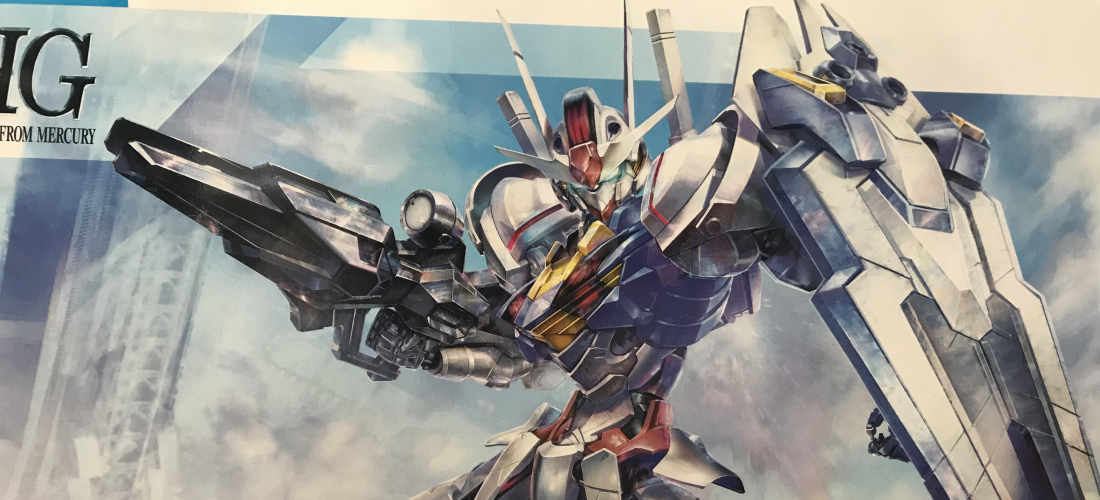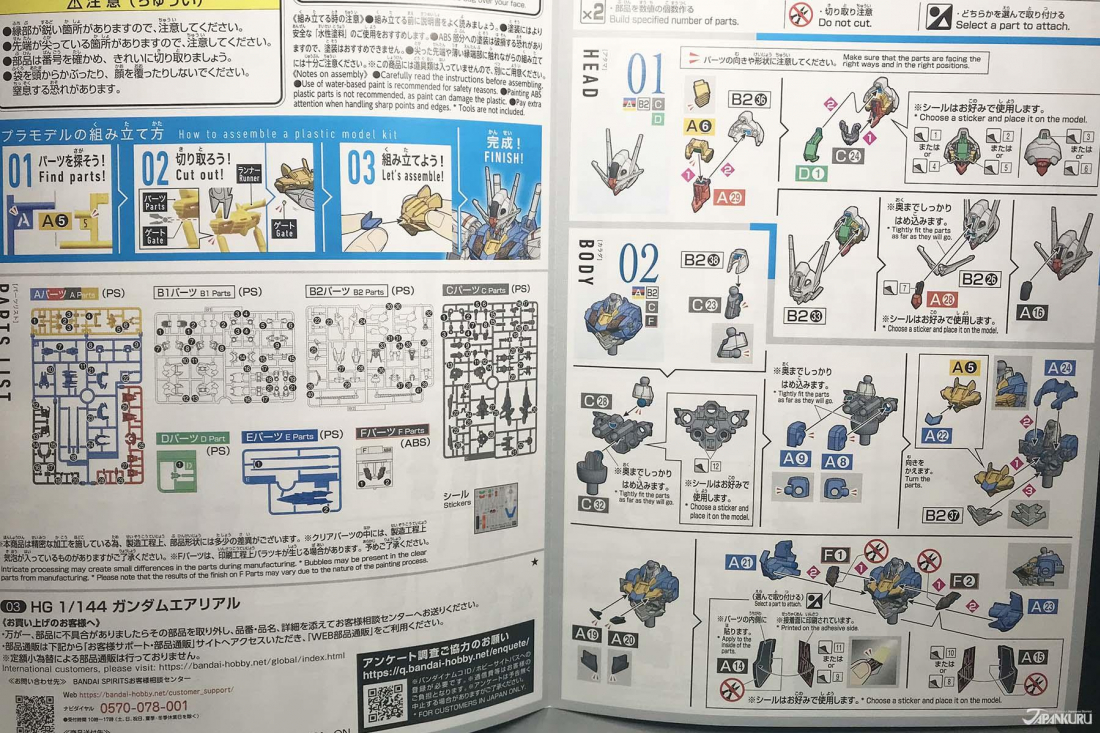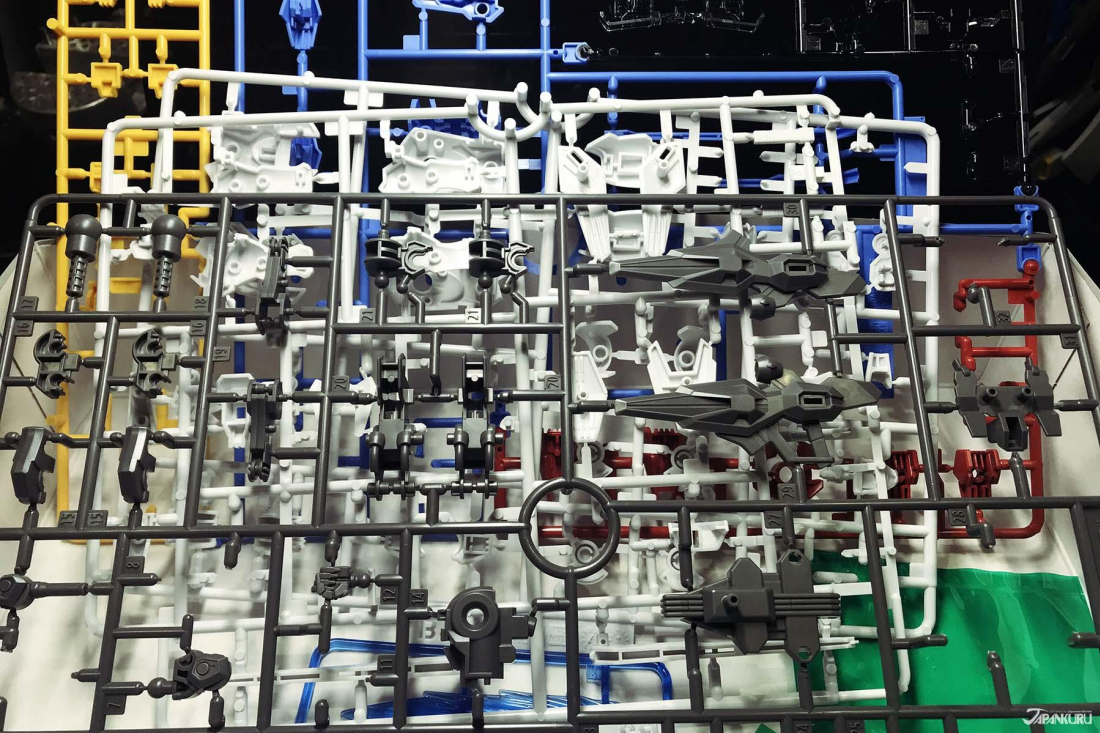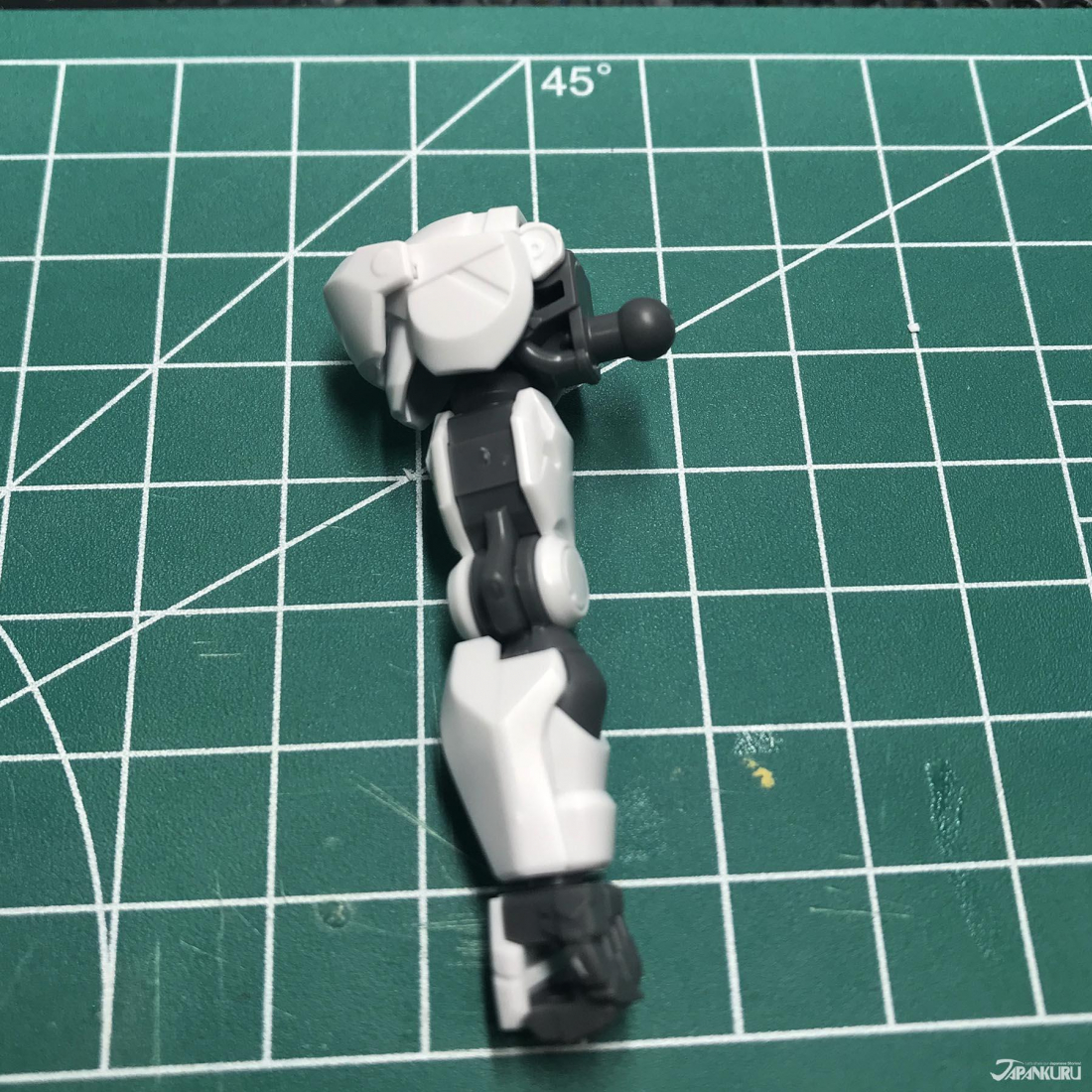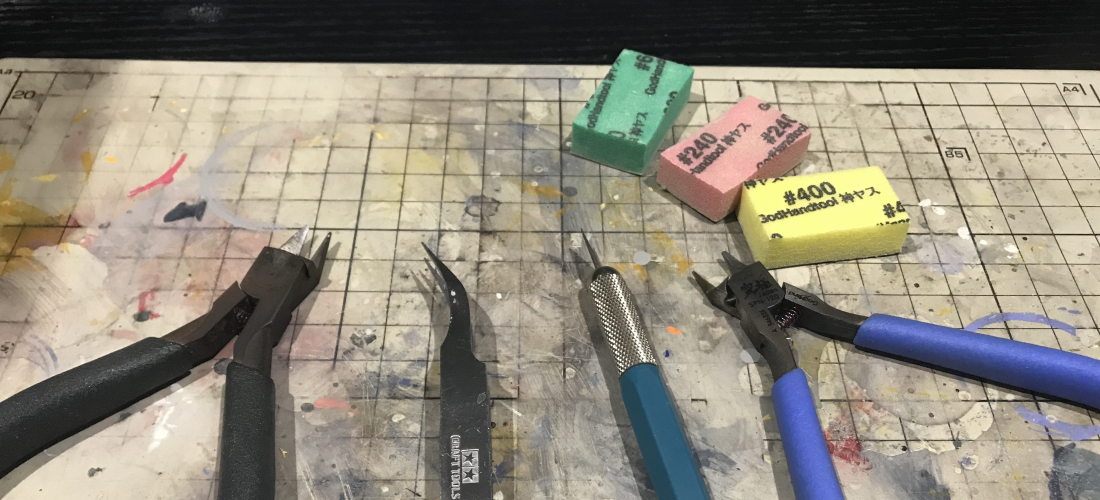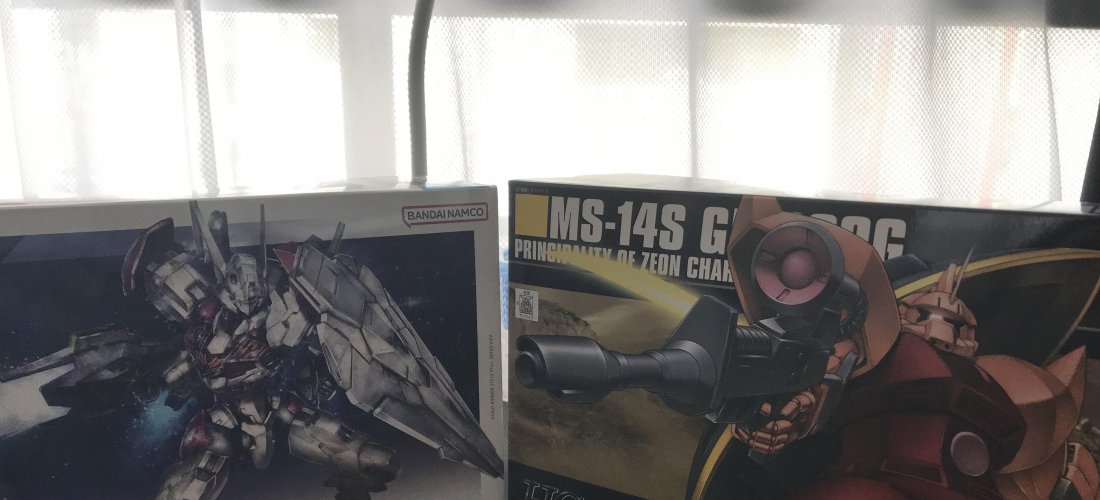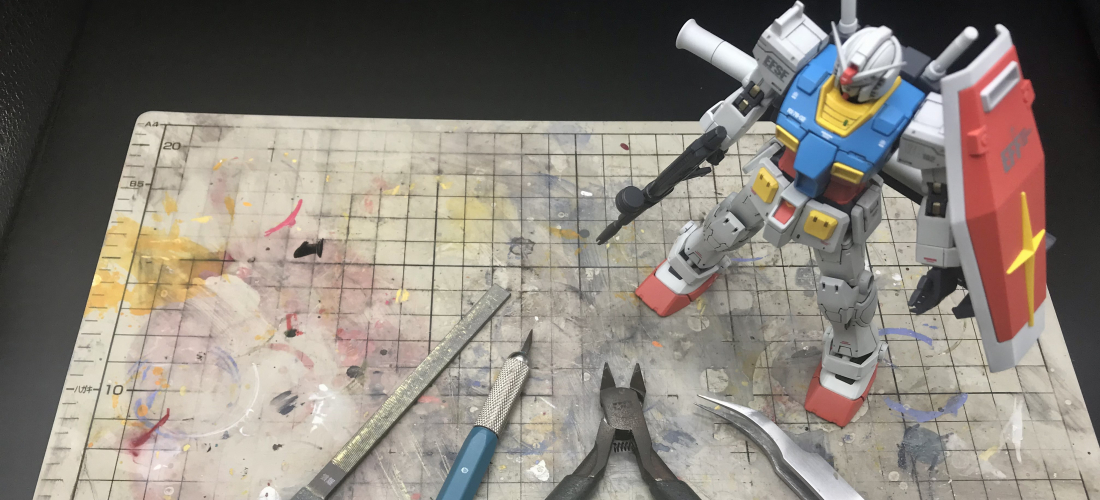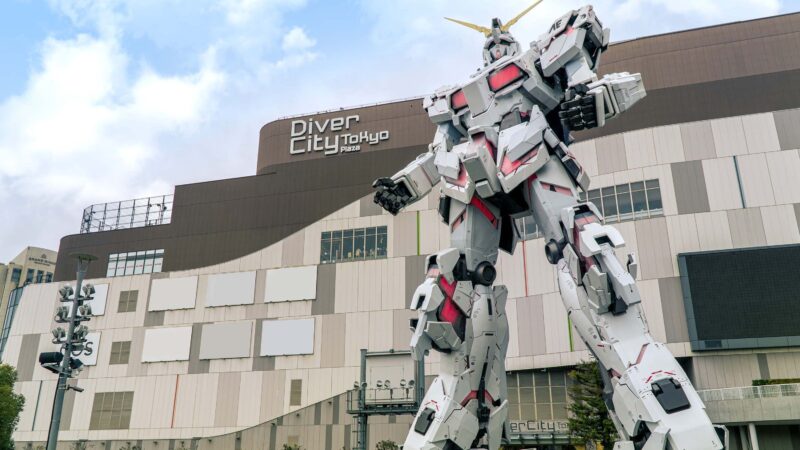CONTENTS
Gundam fans, are you ready to make those Gunpla dreams finally come true? We’ve got all our Gunpla tools ready, and now it’s time to actually put one together!
Gunpla Unboxing & Prep
Ready to make Gunpla your new hobby? In the first installment of this little beginner’s guide to Gunpla, we went over all the tools we’d need. This time, we’re finally going to put the kit together! We’ll be constructing a 1/144 Gundam Aerial, so let’s get started, and open up that box!
The first thing you pull from the box will be a package of “runners” with all of the little Gunpla parts attached, and so our first step is to open that package up for inspection. Each of the runners inside is labeled for identification, usually using the alphabet (A Runner, B Runner, etc.) or a combination of letters and numbers (A1, A2, etc). To make things easier for yourself while you work on your model, you’ll want to get all of the runners in order when you get them out of the box! If you don’t mind spending a little extra on your Gunpla setup, you could even pick up some specially-made “runner stands,” which help you efficiently organize your runners.
▲ A runner straight from the package.
When removing your runners from the box and organizing them, make sure you check the instruction booklet as you go. When it comes to Gunpla, this little instruction booklet is the be all and end all. You won’t get anywhere without it. The pages contain lists of the parts and where they are on the runners, so you can check to make sure your kit isn’t missing any parts.
▲ The instruction booklet.
▲ All the runners piled up in order.
Start Putting Together Your Gunpla
If you’ve got your runners and your instruction booklet all laid out in front of you, it’s finally time to start construction! Give the booklet a thorough read, and follow the instructions step by step to start putting things together. The first part of the process for each step is to check the runner label in the instructions, and cut off the parts you need for that step. As you do that, there are two things to keep in mind.
① Always use your nippers (wire cutters).
When you’re removing the parts from your runners, your hands are a no-go. For the vast majority of Gunpla kits (except for special cases like EG/Entry Grade kits) the parts and runners are connected by bits of plastic called “gates,” and this thin plastic is usually weak enough that you could easily rip the parts away. But pulling the parts off with your hands is a risky business – it’s easy to accidentally leave holes or ugly marks on your model parts, leaving them looking far from perfect. (This can sometimes happen if you try to use everyday scissors as well, so purpose-made nippers are really your best bet.)
▲ Purpose-built plastic model nippers.
② Prepare your parts using a 2-cut process.
When you’re cutting Gunpla parts off a runner, you’ll be cutting the gate part, but if you’re thinking you want to cut right up against the part, then hold your horses. First, you always want to cut it so that a little bit of the gate is still connected to the part, generally called a “nub” in English. These days you can find nippers that are so high quality that you can cut directly up against the part, but in most cases, doing so will leave a little white spot called a “gate mark” or “nub mark.” The nippers are forcing the plastic in ways that just don’t look all that pretty. To avoid the white spots on your parts, leave a little nub (about 1mm is fine) when cutting away from the runner. Then, go back to the part, and carefully align the cutting edge of your nippers where the nub meets the part for a clean cut that won’t leave a scar.
▲ First snip the gates to cut the parts away from the runner.
▲ A sample part with its nubs intact.
▲ Go in for the second cut of your 2-cut process.
Follow the Steps for Easy Construction
Now that our parts are all cleaned up with the 2-cut process and ready to use, let’s move on to putting them together. As mentioned a while back in our intro guide for Gunpla beginners, Gunpla uses a “snap-fit” adhesive-free system, so the pieces fit together with a satisfying snap – no glue needed. The pegs pop right into the corresponding holes to keep everything together. And if you accidentally put the wrong parts together, there’s no need to get frazzled, you just have to carefully pull them back apart. If you panic and start trying to force the pieces you might end up breaking them instead, so if you’re having a really hard time getting the pieces apart without brute force, then you can just use a “parts opener” to help with the process!
And a little tip for the little pieces: sometimes Gunpla parts can get pretty small, so once you’ve cut them away from the runners you’ll want to keep them all together while you work. And don’t forget the little decal stickers either! When you’re snipping the pieces away from the runners and snapping them together one after another, it’s easy to zone out and go on full steam ahead. Remember to check the instructions for any stickers you might need to attach as you go.
▲ Freshly cut parts.
▲ A selection of parts assembled into an arm.
Finish Your Gunpla
If you stick to the tips above and put together all the parts according to the steps in the instruction booklet, you’ll have yourself a finished Gunpla model! Once you’re done you can do whatever you want with it – keep the finished Gunpla on your desk to admire throughout the day, or take pictures of it in cool poses!
When you first start your Gunpla journey, the whole model-building process can take some time, but the more time and effort goes into the Gunpla, the stronger the sense of accomplishment you feel when you see the fruits of your labor! And don’t sweat the small stuff. When you first start building Gunpla, you’re bound to make a few mistakes, but if you can look past them and just aim for the goal of finishing your Gunpla, that’s what’s important!
▲ Our finished 1/144 Gundam Aerial.
In Conclusion
So, now that we’ve followed the Gunpla construction process from start to finish, how does it feel? In this article we’ve gone over the foundations of Gunpla, and if you use the tips above, soon enough you too will join the ranks of splendid Gunpla model makers! The kit used in this article is far from the only one available, so explore the wide variety of Gunpla kits currently on the market. If you challenge yourself with more and more complicated kits, you’ll be able to polish your skills to perfection!
That’s all for now, but look out for more tips in the future, including some techniques for intermediate and advanced Gunpla model makers!
For more info and updates from Japan, check Japankuru for new articles, and don’t forget to follow us on X (Twitter), Instagram, and Facebook!
Original Author: Mame Kakao
English Edition: Sophia Appelbaum
Thirty years old and a huge fan of Gunpla! I recently bought a new photo box, so I started posting on Twitter too. I'll be sharing the hottest news on Gunpla and the like!
COMMENT
FEATURED MEDIA
VIEW MORE 
A New Tokyo Animal Destination: Relax & Learn About the World’s Animals in Japan
#pr #japankuru #anitouch #anitouchtokyodome #capybara #capybaracafe #animalcafe #tokyotrip #japantrip #카피바라 #애니터치 #아이와가볼만한곳 #도쿄여행 #가족여행 #東京旅遊 #東京親子景點 #日本動物互動體驗 #水豚泡澡 #東京巨蛋城 #เที่ยวญี่ปุ่น2025 #ที่เที่ยวครอบครัว #สวนสัตว์ในร่ม #TokyoDomeCity #anitouchtokyodome

Shohei Ohtani Collab Developed Products & Other Japanese Drugstore Recommendations From Kowa
#pr #japankuru
#kowa #syncronkowa #japanshopping #preworkout #postworkout #tokyoshopping #japantrip #일본쇼핑 #일본이온음료 #오타니 #오타니쇼헤이 #코와 #興和 #日本必買 #日本旅遊 #運動補充能量 #運動飲品 #ช้อปปิ้งญี่ปุ่น #เครื่องดื่มออกกำลังกาย #นักกีฬา #ผลิตภัณฑ์ญี่ปุ่น #อาหารเสริมญี่ปุ่น

도쿄 근교 당일치기 여행 추천! 작은 에도라 불리는 ‘가와고에’
세이부 ‘가와고에 패스(디지털)’ 하나면 편리하게 이동 + 가성비까지 완벽하게! 필름카메라 감성 가득한 레트로 거리 길거리 먹방부터 귀여움 끝판왕 핫플&포토 스폿까지 총집합!
Looking for day trips from Tokyo? Try Kawagoe, AKA Little Edo!
Use the SEIBU KAWAGOE PASS (Digital) for easy, affordable transportation!
Check out the historic streets of Kawagoe for some great street food and plenty of picturesque retro photo ops.
#pr #japankuru #도쿄근교여행 #가와고에 #가와고에패스 #세이부패스 #기모노체험 #가와고에여행 #도쿄여행코스 #도쿄근교당일치기 #세이부가와고에패스
#tokyotrip #kawagoe #tokyodaytrip #seibukawagoepass #kimono #japantrip

Hirakata Park, Osaka: Enjoy the Classic Japanese Theme Park Experience!
#pr #japankuru #hirakatapark #amusementpark #japantrip #osakatrip #familytrip #rollercoaster #retrôvibes #枚方公園 #大阪旅遊 #關西私房景點 #日本親子旅行 #日本遊樂園 #木造雲霄飛車 #히라카타파크 #สวนสนุกฮิราคาตะพาร์ค

🍵Love Matcha? Upgrade Your Matcha Experience With Tsujiri!
・160년 전통 일본 말차 브랜드 츠지리에서 말차 덕후들이 픽한 인기템만 골라봤어요
・抹茶控的天堂!甜點、餅乾、飲品一次滿足,連伴手禮都幫你列好清單了
・ส่องมัทฉะสุดฮิต พร้อมพาเที่ยวร้านดังในอุจิ เกียวโต
#pr #japankuru #matcha #matchalover #uji #kyoto #japantrip #ujimatcha #matchalatte #matchasweets #tsujiri #말차 #말차덕후 #츠지리 #교토여행 #말차라떼 #辻利抹茶 #抹茶控 #日本抹茶 #宇治 #宇治抹茶 #日本伴手禮 #抹茶拿鐵 #抹茶甜點 #มัทฉะ #ของฝากญี่ปุ่น #ชาเขียวญี่ปุ่น #ซึจิริ #เกียวโต

・What Is Nenaito? And How Does This Sleep Care Supplement Work?
・你的睡眠保健品——認識「睡眠茶氨酸錠」
・수면 케어 서플리먼트 ‘네나이토’란?
・ผลิตภัณฑ์เสริมอาหารดูแลการนอน “Nenaito(ネナイト)” คืออะไร?
#pr #japankuru #sleepcare #japanshopping #nenaito #sleepsupplement #asahi #睡眠茶氨酸錠 #睡眠保健 #朝日 #l茶胺酸 #日本藥妝 #日本必買 #일본쇼핑 #수면 #건강하자 #네나이토 #일본영양제 #อาหารเสริมญี่ปุ่น #ช้อปปิ้งญี่ปุ่น #ร้านขายยาญี่ปุ่น #ดูแลตัวเองก่อนนอน #อาซาฮิ

Japanese Drugstore Must-Buys! Essential Items from Hisamitsu® Pharmaceutical
#PR #japankuru #hisamitsu #salonpas #feitas #hisamitsupharmaceutical #japanshopping #tokyoshopping #traveltips #japanhaul #japantrip #japantravel

Whether you grew up with Dragon Ball or you just fell in love with Dragon Ball DAIMA, you'll like the newest JINS collab. Shop this limited-edition Dragon Ball accessory collection to find some of the best Dragon Ball merchandise in Japan!
>> Find out more at Japankuru.com! (link in bio)
#japankuru #dragonball #dragonballdaima #animecollab #japanshopping #jins #japaneseglasses #japantravel #animemerch #pr

This month, Japankuru teamed up with @official_korekoko to invite three influencers (originally from Thailand, China, and Taiwan) on a trip to Yokohama. Check out the article (in Chinese) on Japankuru.com for all of their travel tips and photography hints - and look forward to more cool collaborations coming soon!
【橫濱夜散策 x 教你怎麼拍出網美照 📸✨】
每次來日本玩,是不是都會先找旅日網紅的推薦清單?
這次,我們邀請擁有日本豐富旅遊經驗的🇹🇭泰國、🇨🇳中國、🇹🇼台灣網紅,帶你走進夜晚的橫濱!從玩樂路線到拍照技巧,教你怎麼拍出最美的夜景照。那些熟悉的景點,換個視角說不定會有新發現~快跟他們一起出發吧!
#japankuru #橫濱紅磚倉庫 #汽車道 #中華街 #yokohama #japankuru #橫濱紅磚倉庫 #汽車道 #中華街 #yokohama #yokohamaredbrickwarehouse #yokohamachinatown

If you’re a fan of Vivienne Westwood's Japanese designs, and you’re looking forward to shopping in Harajuku this summer, we’ve got important news for you. Vivienne Westwood RED LABEL Laforet Harajuku is now closed for renovations - but the grand reopening is scheduled for July!
>> Find out more at Japankuru.com! (link in bio)
#japankuru #viviennewestwood #harajuku #omotesando #viviennewestwoodredlabel #viviennewestwoodjapan #비비안웨스트우드 #오모테산도 #하라주쿠 #日本購物 #薇薇安魏斯伍德 #日本時尚 #原宿 #表參道 #japantrip #japanshopping #pr

Ready to see TeamLab in Kyoto!? At TeamLab Biovortex Kyoto, the collective is taking their acclaimed immersive art and bringing it to Japan's ancient capital. We can't wait to see it for ourselves this autumn!
>> Find out more at Japankuru.com! (link in bio)
#japankuru #teamlab #teamlabbiovortex #kyoto #kyototrip #japantravel #artnews
Photos courtesy of teamLab, Exhibition view of teamLab Biovortex Kyoto, 2025, Kyoto ® teamLab, courtesy Pace Gallery

Japanese Makeup Shopping • A Trip to Kamakura & Enoshima With Canmake’s Cool-Toned Summer Makeup
#pr #canmake #enoshima #enoden #에노시마 #캔메이크 #japanesemakeup #japanesecosmetics

⚔️The Robot Restaurant is gone, but the Samurai Restaurant is here to take its place. Check it out, and don't forget your coupon!
🍣신주쿠의 명소 로봇 레스토랑이 사무라이 레스토랑으로 부활! 절찬 쿠폰 발급중
💃18歲以上才能入場的歌舞秀,和你想的不一樣!拿好優惠券去看看~
#tokyo #shinjuku #samurairestaurant #robotrestaurant #tokyotrip #도쿄여행 #신주쿠 #사무라이레스토랑 #이색체험 #할인이벤트 #歌舞伎町 #東京景點 #武士餐廳 #日本表演 #日本文化體驗 #japankuru #japantrip #japantravel #japanlovers #japan_of_insta

Japanese appliance & electronics shopping with our KOJIMA x BicCamera coupon!
用JAPANKURU的KOJIMA x BicCamera優惠券買這些正好❤️
코지마 x 빅 카메라 쿠폰으로 일본 가전 제품 쇼핑하기
#pr #japankuru #japanshopping #kojima #biccamera #japaneseskincare #yaman #dji #osmopocket3 #skincaredevice #日本購物 #美容儀 #相機 #雅萌 #日本家電 #일본여행 #면세 #여행꿀팁 #일본쇼핑리스트 #쿠폰 #일본쇼핑 #일본브랜드 #할인 #코지마 #빅카메라 #japankurucoupon
MAP OF JAPAN
SEARCH BY REGION

LATEST
VIEW MOREEVENT CALENDAR
VIEW MORE





